Efficient Separation and Enrichment of Rubidium in Salt Lake Brine Using High-Performance PAN-KCuFC-PEG Adsorption Composite
Abstract
1. Introduction
2. Results and Discussion
2.1. Material Characterization and Properties
2.2. Adsorption Performance of PAN-KCuFC-PEG
2.2.1. Effect of Pore-Causing Agent on Adsorption Properties
2.2.2. Influence of pH on PAN-KCuFC-PEG
2.2.3. Effect of Adsorption Time on PAN-KCuFC-PEG Adsorption of Rb+ and Its Kinetic Model Fitting
2.2.4. Rb Adsorption Isotherms of PAN-KCuFC-PEG
2.2.5. PAN-KCuFC-PEG Performance in the Presence of Salt Lake Brine Ions
2.2.6. Comparison of Various Adsorbents for Rb+ Adsorption
2.3. PAN-KCuFC-PEG Fixed-Bed Column
2.3.1. Sorption Capacity
2.3.2. Washed Columns
2.3.3. Wash with Low Concentration of NH4Cl
2.3.4. Desorption Experiments
3. Materials and Methods
3.1. Materials
3.2. Synthesis of PAN-KCuFC-PEG
3.3. Characterisation of PAN-KCuFC-PEG
3.4. Sorption Experiments
3.4.1. Adsorption Kinetics
3.4.2. Adsorption Isotherms
3.5. Column Experiments
4. Conclusions
Supplementary Materials
Author Contributions
Funding
Institutional Review Board Statement
Informed Consent Statement
Data Availability Statement
Conflicts of Interest
References
- Lv, Y.; Liu, Y.; Ma, B.; Wang, C.; Chen, Y. Preferential extraction of rubidium from high concentration impurity solution by solvent extraction and preparation of high-purity rubidium salts. Desalination 2023, 545, 116162. [Google Scholar] [CrossRef]
- Bandi, T.N.; Desai, N.M.; Kaintura, J.; Attri, D.; Saiyed, M.A.; Sharma-Kesarkar, R.; Sinha, P.; Ghoshal, B.; Mandal, S.; Ghosh, B.; et al. Advanced space rubidium atomic frequency standard for satellite navigation. GPS Solut. 2022, 26, 54. [Google Scholar] [CrossRef]
- Schofield, R.; Menezes, L.; Underwood, S.R. Nuclear cardiology: State of the art. Heart 2021, 107, 954–961. [Google Scholar] [CrossRef]
- Xie, H.; Zhang, Y.; Liu, P.; Duo, X.; Hu, Z.; Yu, J.; Wang, Z.; Yao, G.; Feng, L.; Huang, X.; et al. Rb-Doped Perovskite Oxides: Surface Enrichment and Structural Reconstruction During the Oxygen Evolution Reaction. Small 2024, 20, e2400668. [Google Scholar] [CrossRef]
- Zektzer, R.; Mazurski, N.; Barash, Y.; Levy, U. Nanoscale atomic suspended waveguides for improved vapour coherence times and optical frequency referencing. Nat. Photonics 2021, 15, 772–779. [Google Scholar] [CrossRef]
- Xing, P.; Wang, C.; Chen, Y.; Ma, B. Rubidium extraction from mineral and brine resources: A review. Hydrometallurgy 2021, 203, 105644. [Google Scholar] [CrossRef]
- Quyet Truong, D.; Choo, Y.; Akther, N.; Roobavannan, S.; Norouzi, A.; Gupta, V.; Blumenstein, M.; Vinh Nguyen, T.; Naidu, G. Selective rubidium recovery from seawater with metal-organic framework incorporated potassium cobalt hexacyanoferrate nanomaterial. Chem. Eng. J. 2023, 454, 140107. [Google Scholar] [CrossRef]
- Sharma, S.K.; Truong, D.Q.; Guo, J.; An, A.K.; Naidu, G.; Deka, B.J. Recovery of rubidium from brine sources utilizing diverse separation technologies. Desalination 2023, 556, 116578. [Google Scholar] [CrossRef]
- Shi, Q.; Wang, Y.; Liu, W.; Zhang, H.; Li, Y.; Jiao, J.; Zhao, W.; Shen, Y. Preparation of polysulfone based rubidium ion imprinted membrane and its selective adsorption and separation performance. React. Funct. Polym. 2023, 191, 105696. [Google Scholar] [CrossRef]
- Zhang, X.; Qin, Z.; Aldahri, T.; Rohani, S.; Ren, S.; Liu, W. Separation and recovery of cesium sulfate from the leach solution obtained in the sulfuric acid baking process of lepidolite concentrate. Hydrometallurgy 2021, 199, 105537. [Google Scholar] [CrossRef]
- Lv, Y.; Xing, P.; Ma, B.; Liu, Y.; Wang, C.; Zhang, W.; Chen, Y. Efficient Extraction of Lithium and Rubidium from Polylithionite via Alkaline Leaching Combined with Solvent Extraction and Precipitation. ACS Sustain. Chem. Eng. 2020, 8, 14462–14470. [Google Scholar] [CrossRef]
- Wang, G.; Zhang, H.; Qian, W.; Tang, A.; Cao, H.; Feng, W.; Zheng, G. Synthesis and assessment of spherogranular composite tin pyrophosphate antimonate adsorbent for selective extraction of rubidium and cesium from salt lakes. Desalination 2024, 581, 117540. [Google Scholar] [CrossRef]
- Qi, C.; Ma, C.; Yang, S.; Guo, Y.; Yan, X.; Xiong, G.; Deng, T. An innovative method for effective rubidium recovery from wastewater using tungsten-doped microsphere magnetic tin sulfide. J. Environ. Chem. Eng. 2024, 12, 113295. [Google Scholar] [CrossRef]
- Chen, S.; Xiong, G.; Cui, S.; Zhao, S.; Lai, J.; Zhang, X.; Zeng, G.; Zeng, Y.; Shi, H. Selective isolation of rubidium with mesoporous silica loaded with ammonium phosphomolybdate via an in-pore crystallization reaction. Sep. Purif. Technol. 2025, 353, 128364. [Google Scholar] [CrossRef]
- Maslova, M.V.; Ivanenko, V.I.; Gerasimova, L.G.; Vilkova, N.L. Study of the Sorption of Cesium Cations by a Sorbent Based on Titanium Phosphate. Prot. Met. Phys. Chem. Surf. 2019, 55, 833–840. [Google Scholar] [CrossRef]
- Qin, K.; Li, F.; Xu, S.; Wang, T.; Liu, C. Sequential removal of phosphate and cesium by using zirconium oxide: A demonstration of designing sustainable adsorbents for green water treatment. Chem. Eng. J. 2017, 322, 275–280. [Google Scholar] [CrossRef]
- Kleszcz, K.; Mietelski, J.W.; Łokas, E. Potassium influence on the sorption of 134Cs and 83Rb by AMP in fresh and salty waters. J. Radioanal. Nucl. Chem. 2015, 305, 439–443. [Google Scholar] [CrossRef]
- Liu, C.; Li, Y.; Liu, Q.; Liu, J.; Guo, Y.; Yu, X.; Xie, Y.; Deng, T. Highly selective and easily regenerated porous fibrous composite of PSF-Na2.1Ni0.05Sn2.95S7 for the sustainable removal of cesium from wastewater. J. Hazard. Mater. 2022, 436, 129188. [Google Scholar] [CrossRef]
- Durrant, C.B.; Begg, J.D.; Kersting, A.B.; Zavarin, M. Cesium sorption reversibility and kinetics on illite, montmorillonite, and kaolinite. Sci. Total Environ. 2018, 610-611, 511–520. [Google Scholar] [CrossRef]
- Dong, C.; Deng, X.; Guo, X.; Wang, B.; Ye, X.; Fan, J.; Zhu, C.; Fan, F.; Qing, B. Synthesis of potassium metal ferrocyanide/Al-MCM-41 with fast and selective adsorption of cesium. Colloids Surf. A Physicochem. Eng. Asp. 2021, 613, 126107. [Google Scholar] [CrossRef]
- Naidu, G.; Nur, T.; Loganathan, P.; Kandasamy, J.; Vigneswaran, S. Selective sorption of rubidium by potassium cobalt hexacyanoferrate. Sep. Purif. Technol. 2016, 163, 238–246. [Google Scholar] [CrossRef]
- Ni, J.; Sun, B.; Liu, P.; Jin, G.-P. Preparation of a core-shell magnetic potassium nickel copper hexacyanoferrate/zeolitic imidazolate framework composite for rubidium adsorption. J. Solid State Chem. 2024, 331, 124554. [Google Scholar] [CrossRef]
- Le, Q.T.N.; Cho, K. Caesium adsorption on a zeolitic imidazolate framework (ZIF-8) functionalized by ferrocyanide. J. Colloid Interface Sci. 2021, 581, 741–750. [Google Scholar] [CrossRef] [PubMed]
- Kamachi, Y.; Zakaria, M.B.; Torad, N.L.; Nakato, T.; Ahamad, T.; Alshehri, S.M.; Malgras, V.; Yamauchi, Y. Hydrogels Containing Prussian Blue Nanoparticles Toward Removal of Radioactive Cesium Ions. J. Nanosci. Nanotechnol. 2016, 16, 4200–4204. [Google Scholar] [CrossRef]
- Jiang, C.; Ni, J.; Jin, G.-P. Magnetic potassium cobalt hexacyanoferrate nanocomposites for efficient adsorption of rubidium in solution. Sep. Purif. Technol. 2022, 296, 121383. [Google Scholar] [CrossRef]
- Ding, K.; Zhu, G.; Song, C.; Wang, Q.; Wang, L.; Wang, Z.; Meng, C.; Gao, C. Fabrication of polyacrylonitrile-Li1.6Mn1.6O4 composite nanofiber flat-sheet membranes via electrospinning method as effective adsorbents for Li+ recovery from salt-lake brine. Sep. Purif. Technol. 2022, 284, 120242. [Google Scholar] [CrossRef]
- Naidu, G.; Loganathan, P.; Jeong, S.; Johir, M.A.H.; To, V.H.P.; Kandasamy, J.; Vigneswaran, S. Rubidium extraction using an organic polymer encapsulated potassium copper hexacyanoferrate sorbent. Chem. Eng. J. 2016, 306, 31–42. [Google Scholar] [CrossRef]
- Zong, Y.; Zhang, Y.; Lin, X.; Ye, D.; Qiao, D.; Zeng, S. Facile synthesis of potassium copper ferrocyanide composite particles for selective cesium removal from wastewater in the batch and continuous processes. RSC Adv. 2017, 7, 31352–31364. [Google Scholar] [CrossRef]
- Hu, J.; Chen, S.; Zhang, N.; Wang, Z.; Shi, J.; Guo, Y.; Deng, T. Porous composite CMC–KCuFC–PEG spheres for efficient cesium removal from wastewater. N. J. Chem. 2019, 43, 9658–9665. [Google Scholar] [CrossRef]
- Tsai, H.-A.; Ma, L.-C.; Yuan, F.; Lee, K.-R.; Lai, J.-Y. Investigation of post-treatment effect on morphology and pervaporation performance of PEG added PAN hollow fiber membranes. Desalination 2007, 234, 232–243. [Google Scholar] [CrossRef]
- Dagan-Jaldety, C.; Nativ, P.; Cristal, Y.S.; Lahav, O. A Prussian-blue analogue (PBA) ion-chromatography-based technique for selective separation of Rb+ (as RbCl) from brines. Water Res. 2023, 247, 120757. [Google Scholar] [CrossRef] [PubMed]
- Sidey, V. On the effective ionic radii for ammonium. Acta Crystallogr. Sect. B Struct. Sci. Cryst. Eng. Mater. 2016, 72, 626–633. [Google Scholar] [CrossRef] [PubMed]
- Hamoud, M.A.; Allan, K.F.; Sanad, W.A.; Saad, E.A.; Mahmoud, M.R. Synthesis of PAN/ferrocyanide composite incorporated with cetrimonium bromide and its employment as a bifunctional adsorbent for coremoval of Cs+ and HCrO4− from aqueous solutions. J. Radioanal. Nucl. Chem. 2020, 324, 647–661. [Google Scholar] [CrossRef]
- Du, Z.; Jia, M.; Wang, X. Cesium removal from solution using PAN-based potassium nickel hexacyanoferrate (II) composite spheres. J. Radioanal. Nucl. Chem. 2012, 298, 167–177. [Google Scholar] [CrossRef]
- Melnychenko, T.; Kadoshnikov, V.; Lytvynenko, Y.; Pysanska, I.; Zabulonov, Y.; Marysyk, S.; Krasnoholovets, V. Nanodispersion of ferrocianides for purification of man-made contaminated water containing caesium. J. Environ. Radioact. 2023, 261, 107135. [Google Scholar] [CrossRef]
- Kim, Y.; Kim, Y.K.; Kim, S.; Harbottle, D.; Lee, J.W. Nanostructured potassium copper hexacyanoferrate-cellulose hydrogel for selective and rapid cesium adsorption. Chem. Eng. J. 2017, 313, 1042–1050. [Google Scholar] [CrossRef]
- Jiang, C.; Wang, X.; Wang, G.; Hao, C.; Li, X.; Li, T. Adsorption performance of a polysaccharide composite hydrogel based on crosslinked glucan/chitosan for heavy metal ions. Compos. Part B Eng. 2019, 169, 45–54. [Google Scholar] [CrossRef]
- Epsztein, R.; Shaulsky, E.; Qin, M.; Elimelech, M. Activation behavior for ion permeation in ion-exchange membranes: Role of ion dehydration in selective transport. J. Membr. Sci. 2019, 580, 316–326. [Google Scholar] [CrossRef]
- Xiufang, S.; Yi, W.; Haiyan, Z.; Yi, S.; Qiang, S.; Huanhuan, C.; Jiankui, S.; Zhiguo, Z. Fabrication and performance of the ammonium molybdophosphate/polysulfone mixed matrix membranes for rubidium adsorption in aqueous solution. J. Appl. Polym. Sci. 2021, 139, 51798. [Google Scholar]
- Dai, W.; Fang, Y.; Yu, L.; Zhao, G.; Yan, X. Rubidium ion capture with composite adsorbent PMA@HKUST-1. J. Taiwan Inst. Chem. Eng. 2018, 84, 222–228. [Google Scholar] [CrossRef]
- Fang, Y.; Zhao, G.; Dai, W.; Ma, L.; Ma, N. Enhanced adsorption of rubidium ion by a phenol@MIL-101(Cr) composite material. Microporous Mesoporous Mater. 2017, 251, 51–57. [Google Scholar] [CrossRef]
- Wang, Y.; Zhang, Q.; Li, K.; Wang, C.; Fang, D.; Han, W.; Lu, M.; Ye, X.; Zhang, H.; Liu, H.; et al. Efficient Selective Adsorption of Rubidium and Cesium from Practical Brine Using a Metal-Organic Framework-Based Magnetic Adsorbent. Langmuir ACS J. Surf. Colloids 2024, 40, 9688–9701. [Google Scholar] [CrossRef] [PubMed]
- Xu, H.; Lin, P.; Liu, P.J.; Liu, H.G.; Guo, H.B.; Wu, C.X.; Fang, M.; Zhang, X.; Jin, G.P. Removal of rubidium from brine by an integrated film of sulfonated polysulfone/graphene/potassium copper ferricyanide. Chin. J. Chem. Eng. 2024, 69, 112–121. [Google Scholar] [CrossRef]
- Zhang, D.; Zhang, K.; Hu, X.; He, Q.; Yan, J.; Xue, Y. Cadmium removal by MgCl2 modified biochar derived from crayfish shell waste: Batch adsorption, response surface analysis and fixed bed filtration. J. Hazard. Mater. 2021, 408, 124860. [Google Scholar] [CrossRef]
- Ngah, W.S.W.; Ab Ghani, S.; Kamari, A. Adsorption behaviour of Fe(II) and Fe(III) ions in aqueous solution on chitosan and cross-linked chitosan beads. Bioresour. Technol. 2005, 96, 443–450. [Google Scholar] [CrossRef]
- Naidu, G.; Jeong, S.; Choi, Y.; Song, M.H.; Oyunchuluun, U.; Vigneswaran, S. Valuable rubidium extraction from potassium reduced seawater brine. J. Clean. Prod. 2018, 174, 1079–1088. [Google Scholar] [CrossRef]
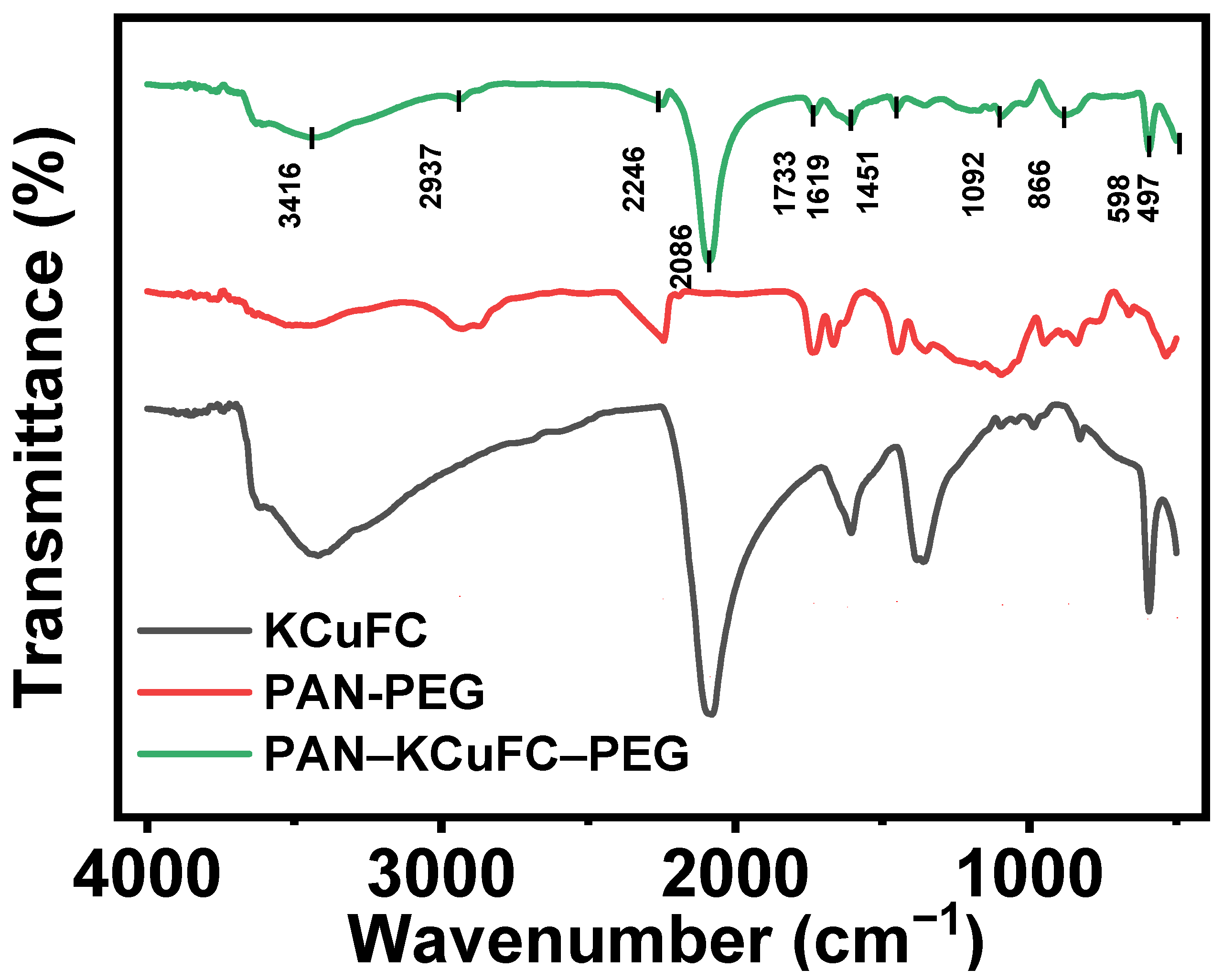
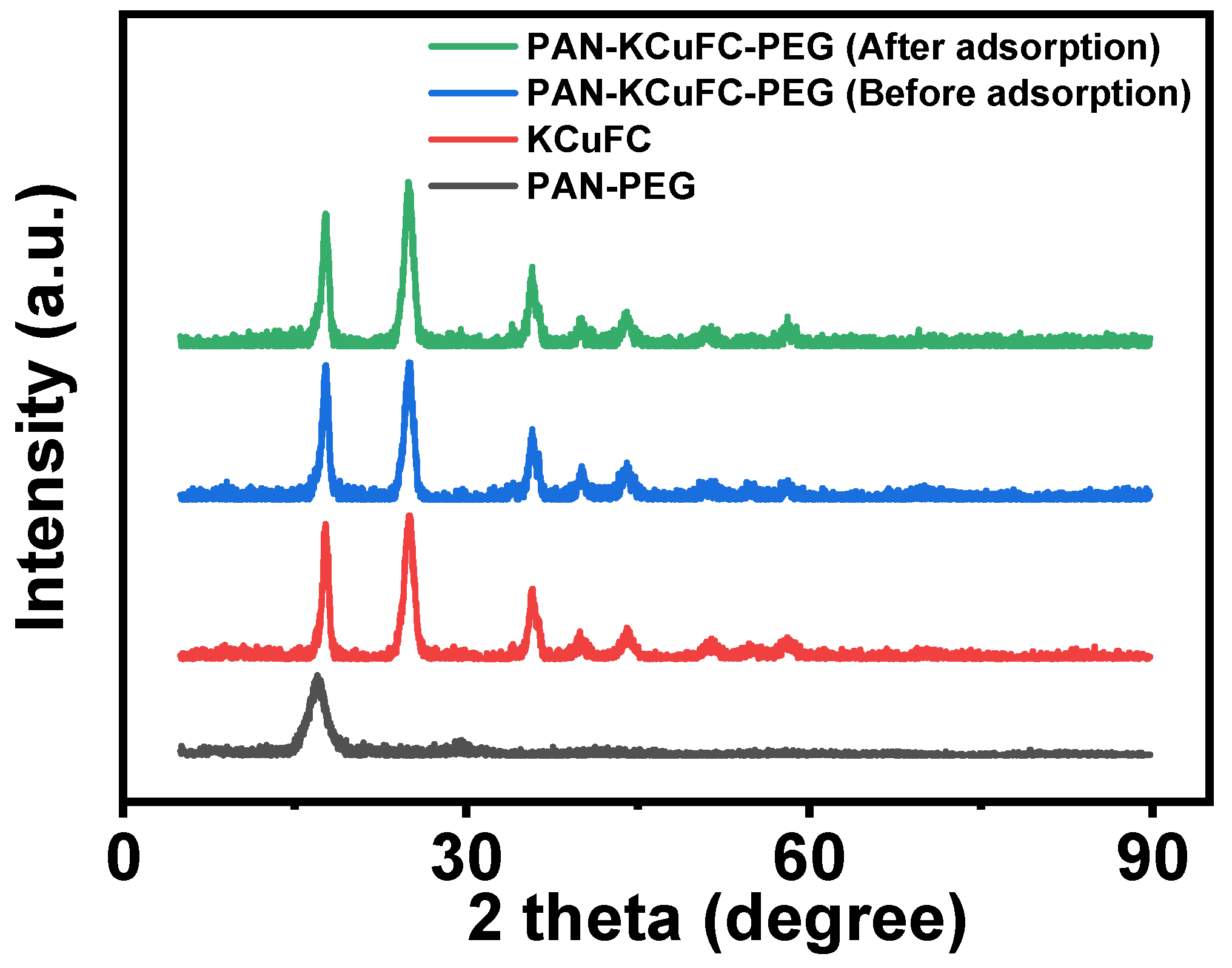

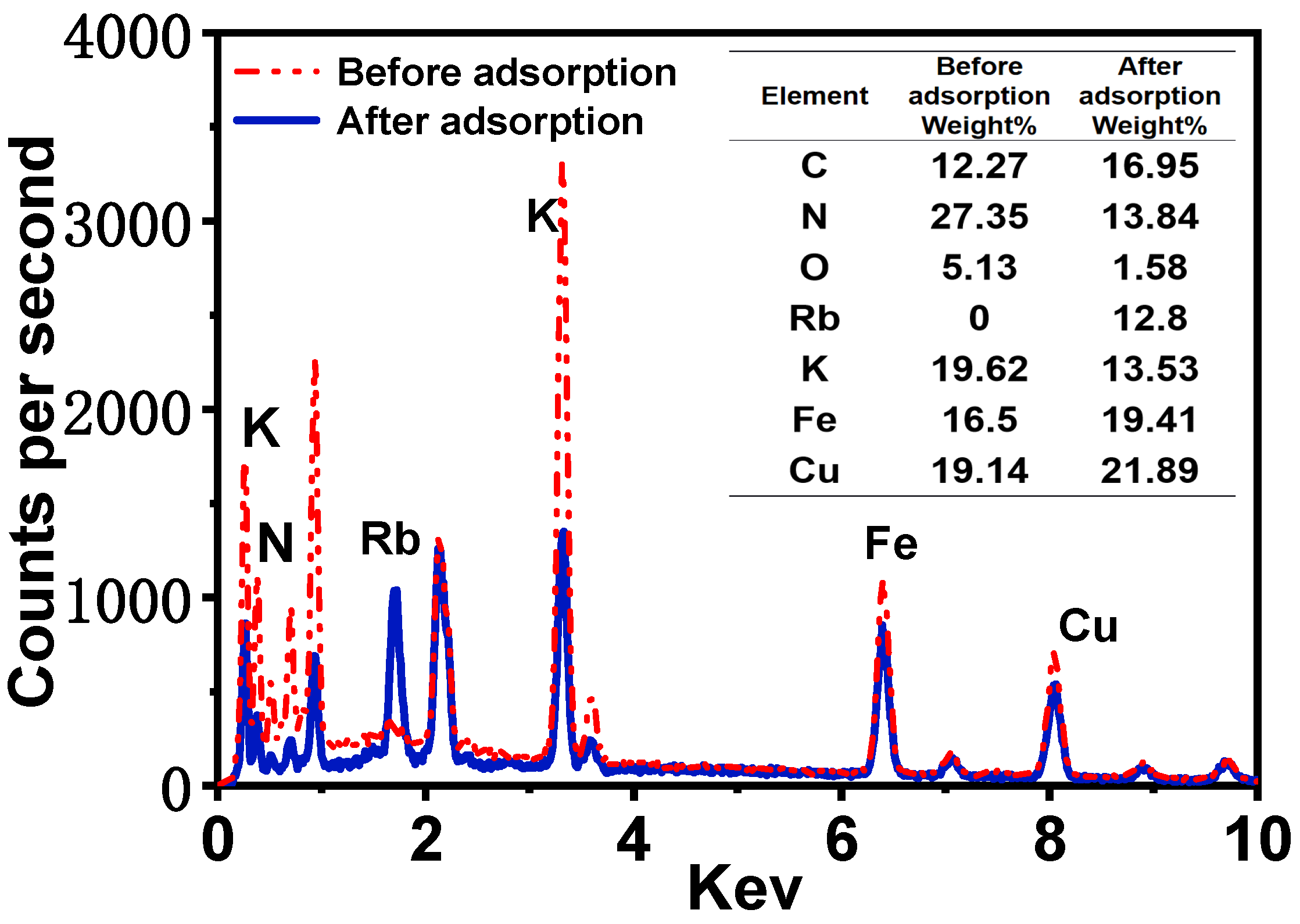
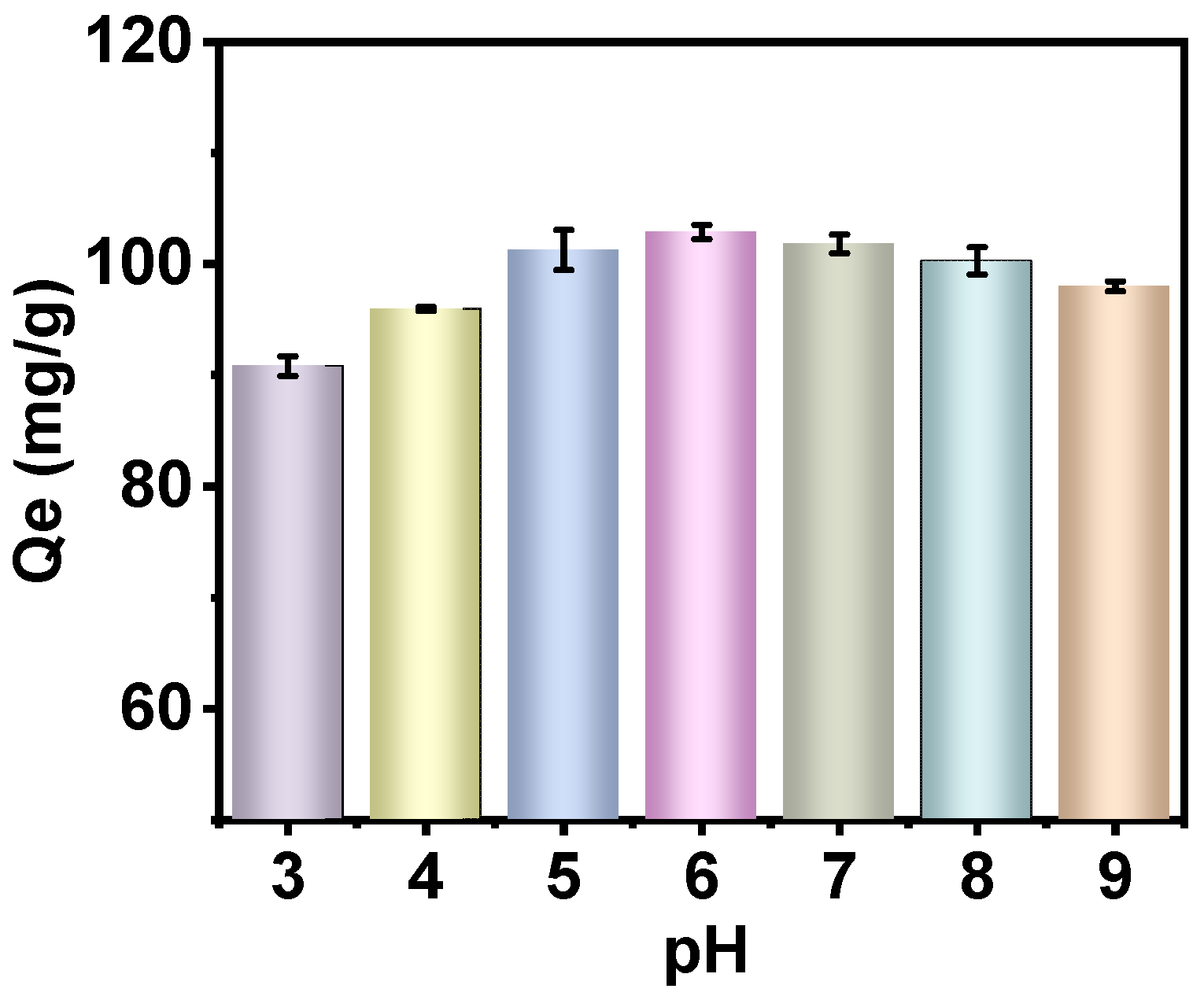
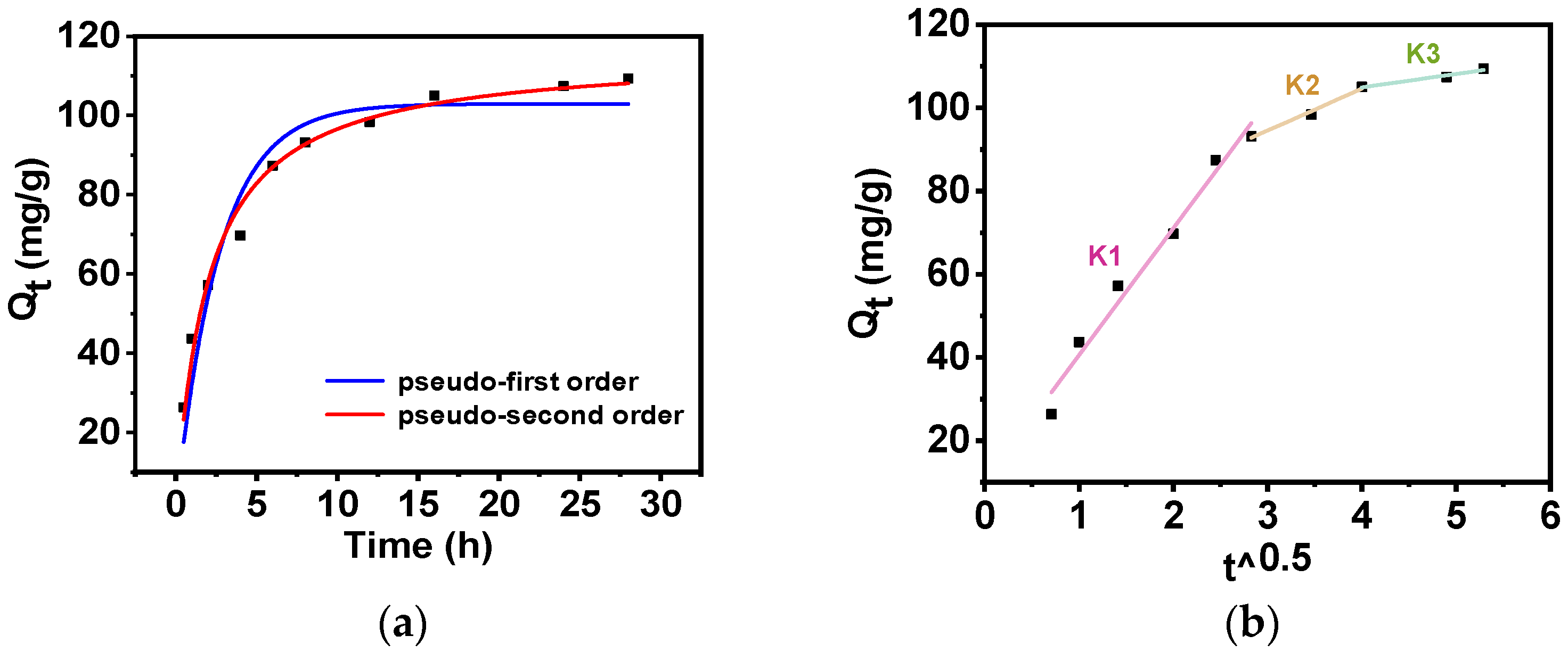
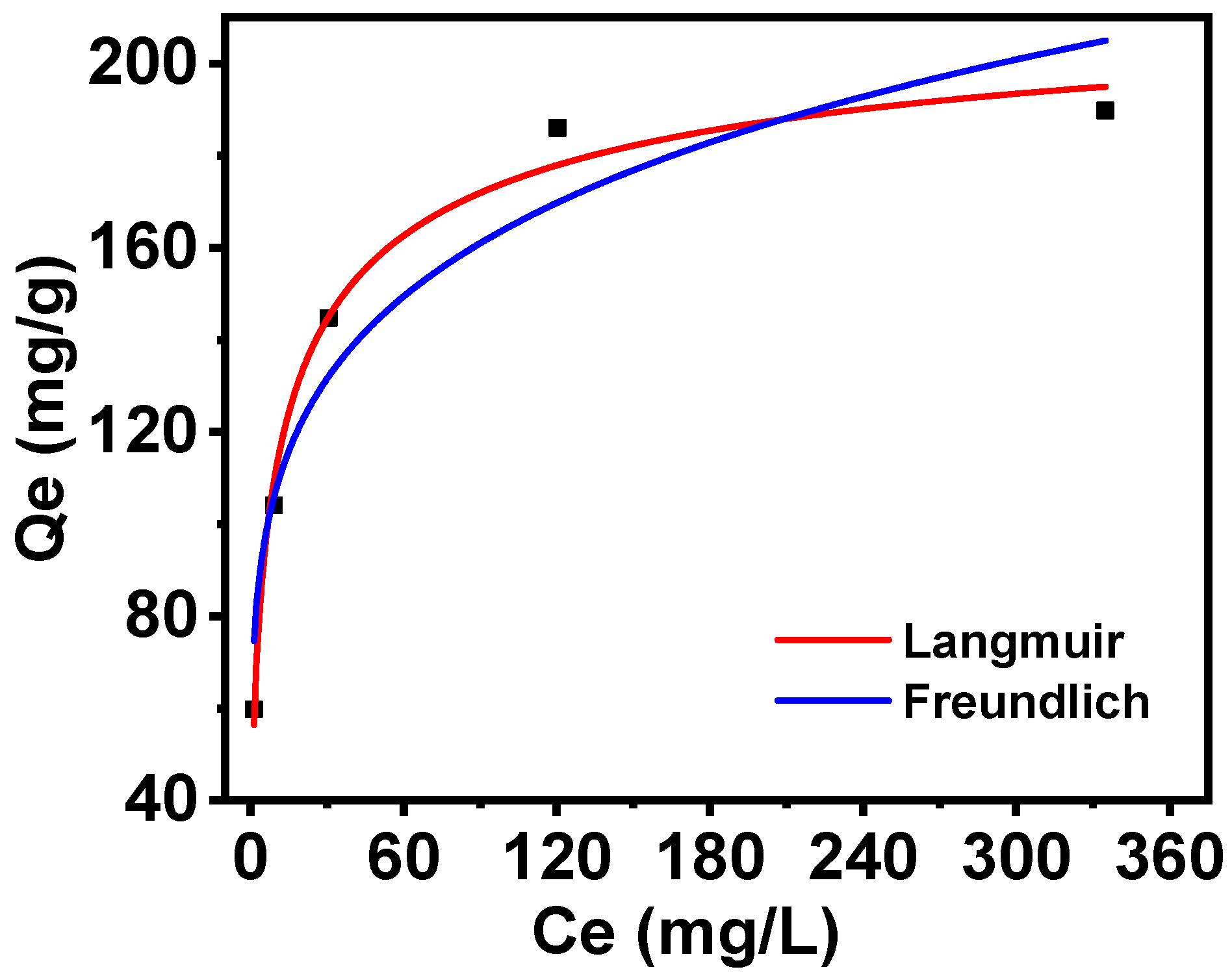
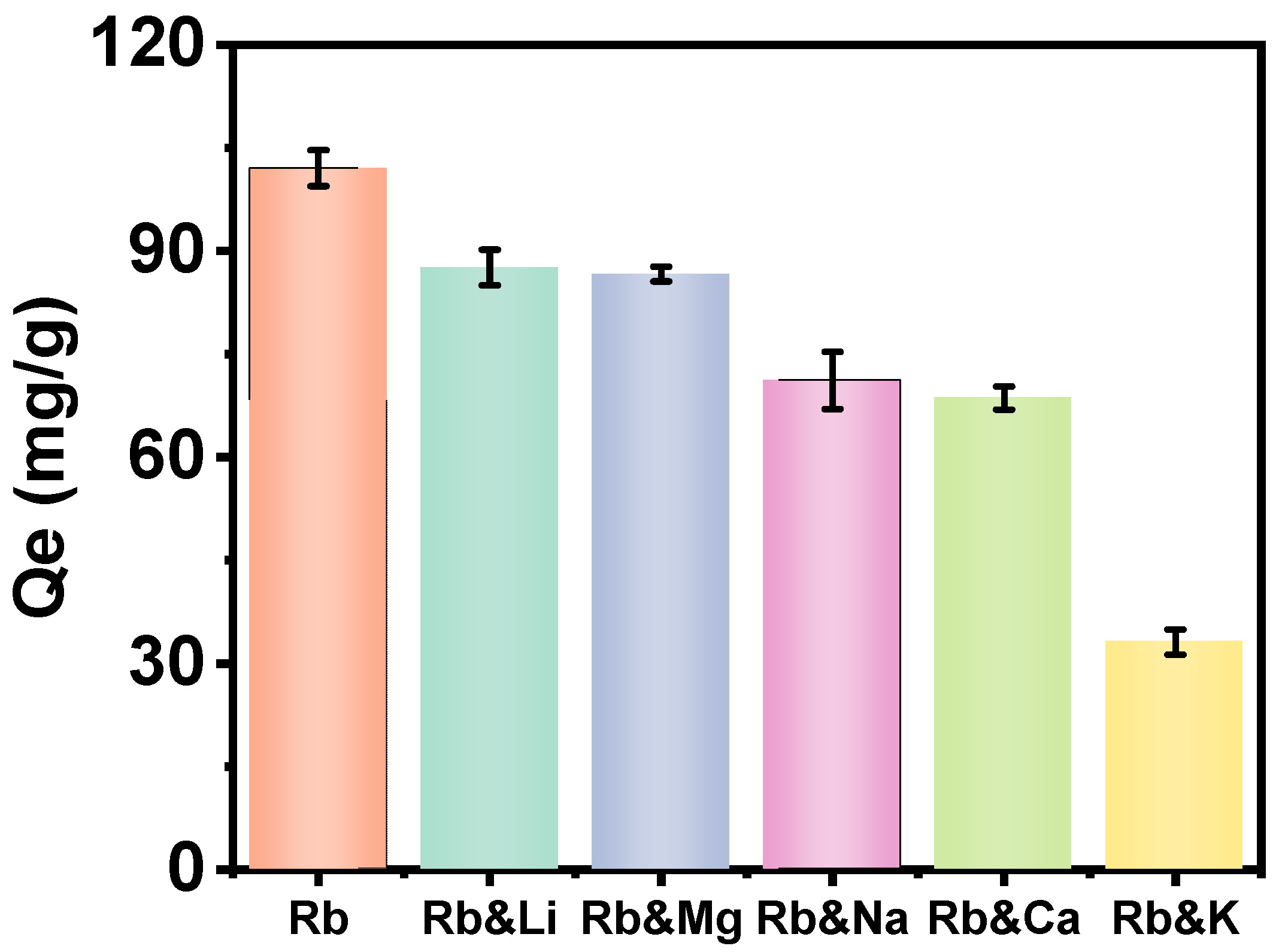
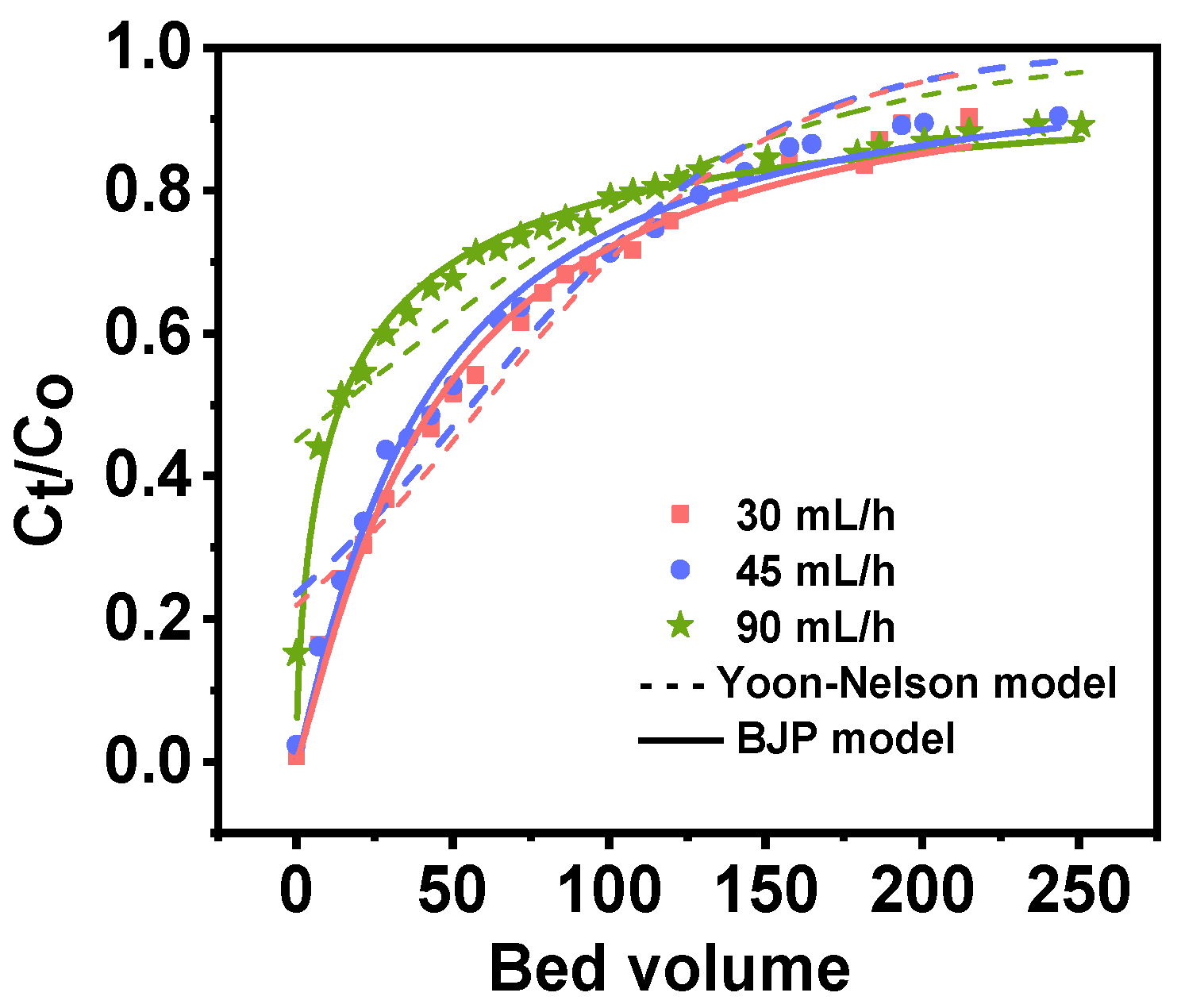
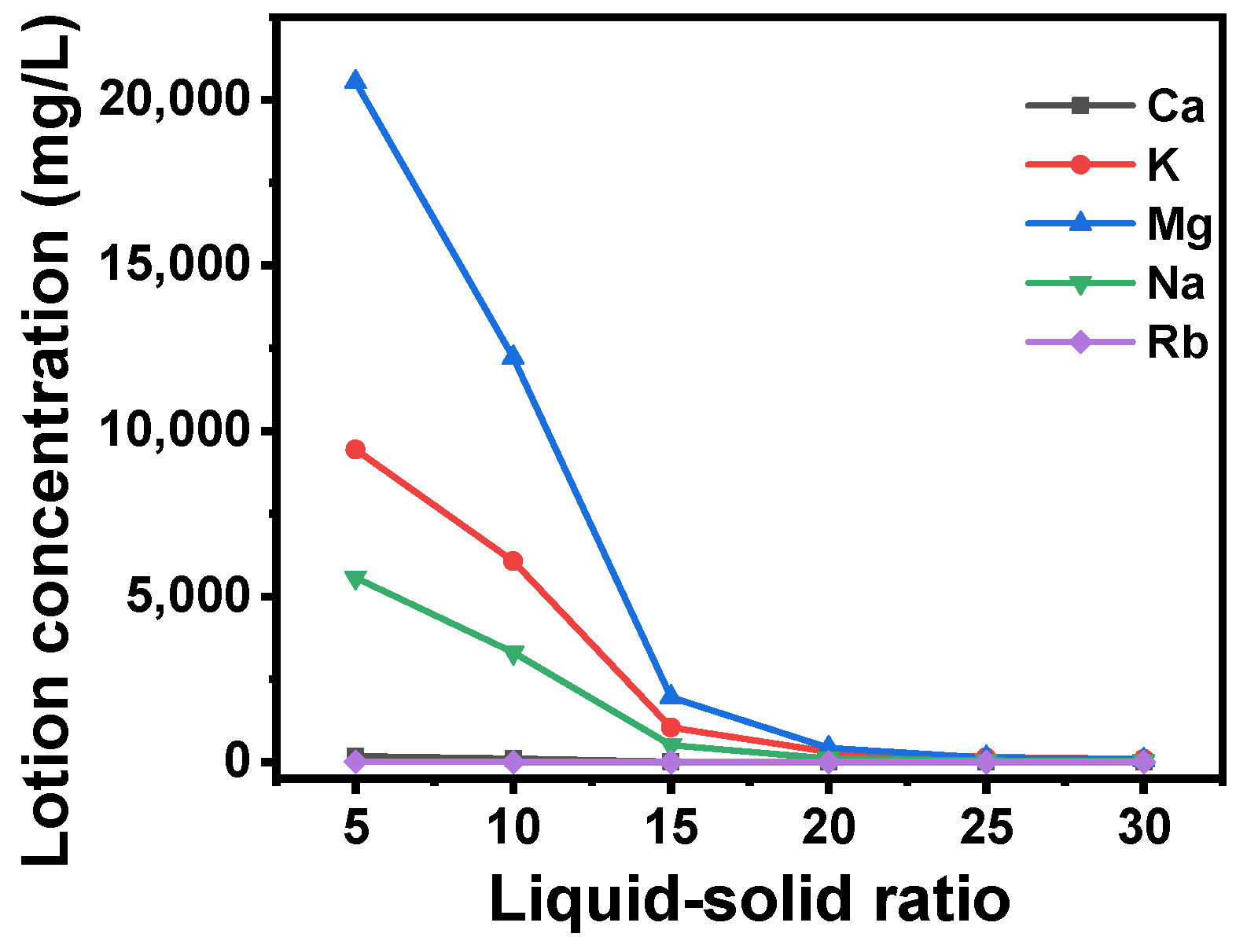

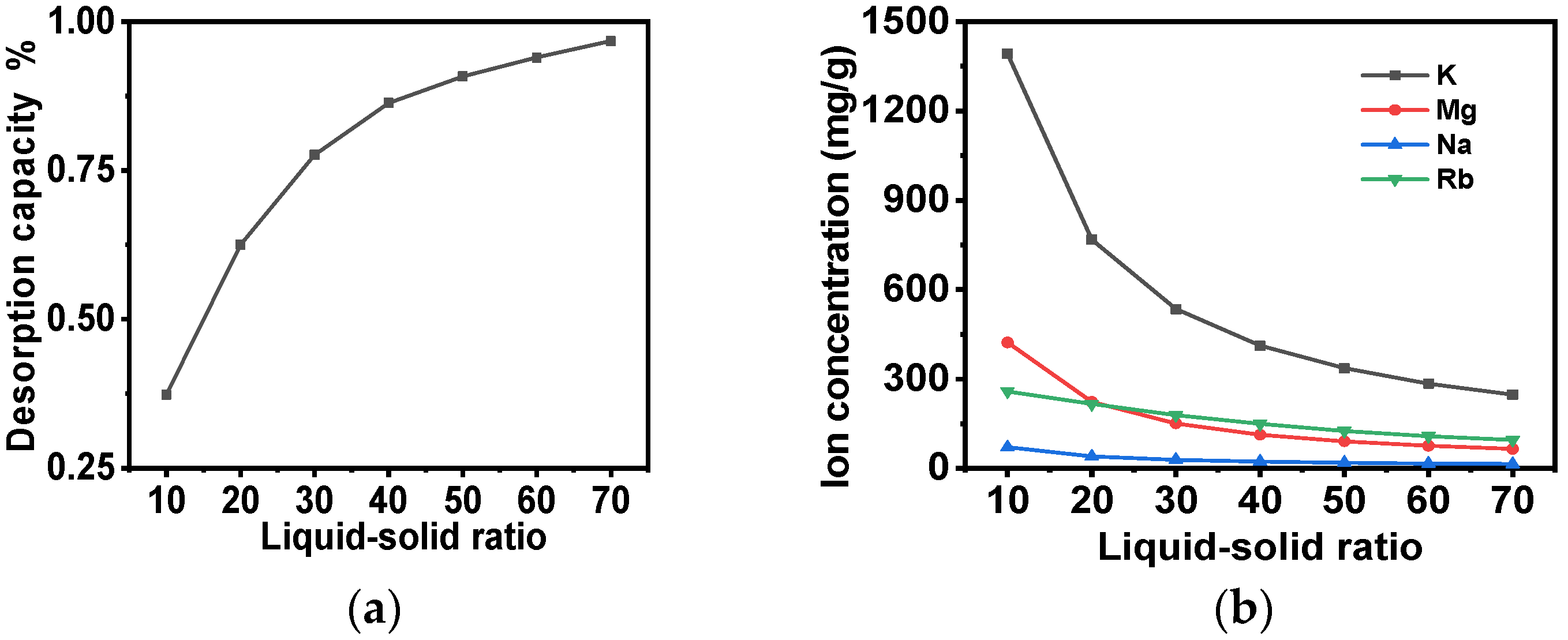
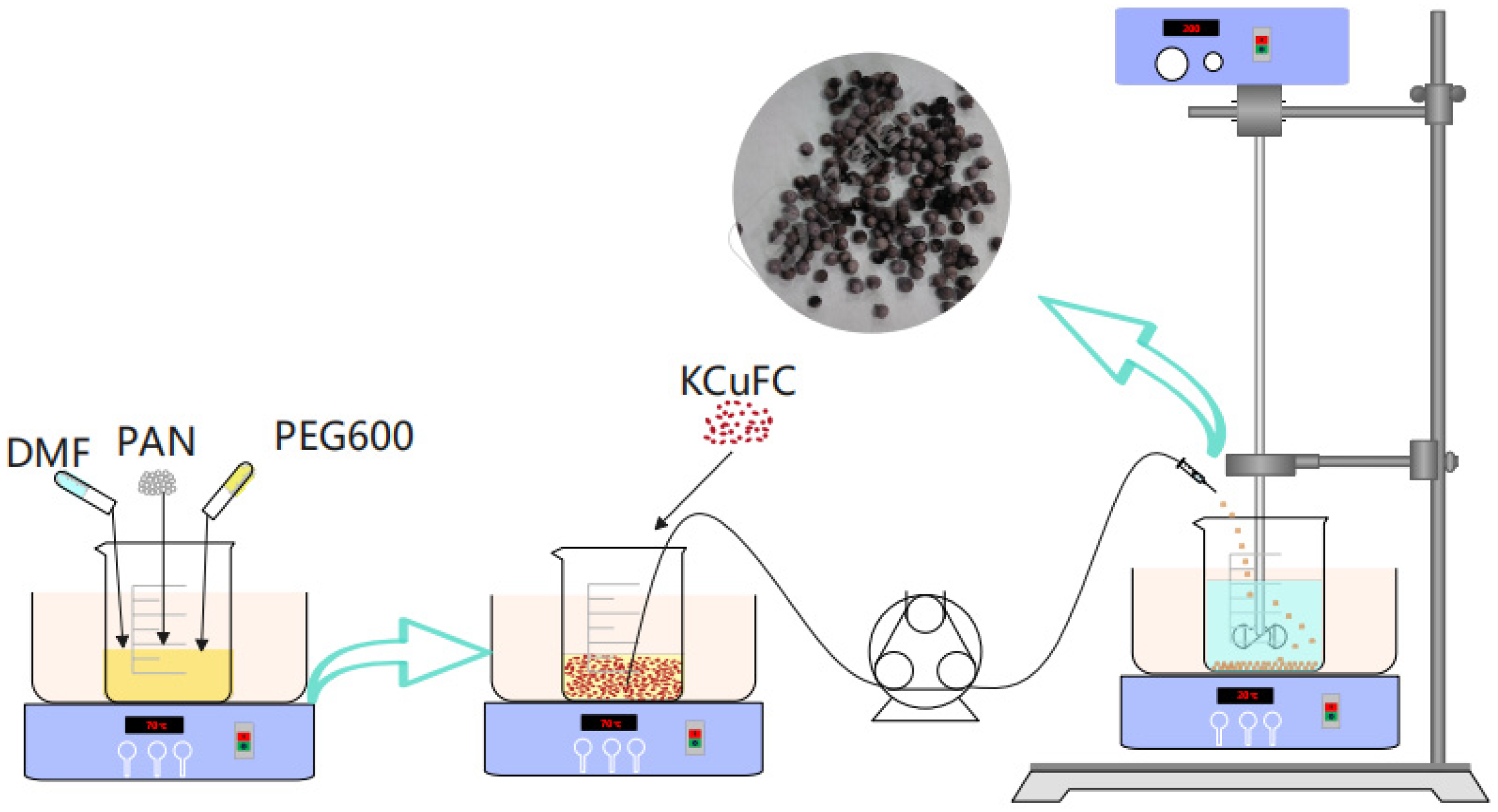
| Sample | Pore Volume | BET Surface Area | Average Pore Diameter | Qe |
|---|---|---|---|---|
| (cm3/g) | (m2/g) | (nm) | (mg/g) | |
| KCuFC-PAN | 0.0205 | 5.30 | 26.93 | 54.61 |
| KCuFC-PAN-PEG | 0.0335 | 14.46 | 11.99 | 62.17 |
| KCuFC-PAN-PVP | 0.0162 | 5.611 | 13.31 | 50.84 |
| Pseudo-First-Order Model | Pseudo-Second-Order Model | ||||
|---|---|---|---|---|---|
| Qt (mg/g) | K1 (/h) | R2 | Qt (mg/g) | K2 (/h) | R2 |
| 102 | 0.37 | 0.94 | 115 | 0.004 | 0.98 |
| Parameter | PAN-KCuFC-PEG | |
|---|---|---|
| K1 | K (mg/g/h0.5) | 30.47 |
| C (mg/g) | 10.10 | |
| R2 | 0.97 | |
| K2 | K (mg/g/h0.5) | 10.05 |
| C (mg/g) | 64.38 | |
| R2 | 0.98 | |
| K3 | K (mg/g/h0.5) | 3.24 |
| C (mg/g) | 91.95 | |
| R2 | 0.97 |
| Metal | Hydrated Ionic Radius, Å [36] | Unhydrated Ionic Radius, Å [35] |
|---|---|---|
| Rb | 2.26–2.28 | 1.68 |
| K | 2.32–3.31 | 1.48 |
| Ca | 4.1–4.13 | 1.01 |
| Na | 2.76–3.60 | 0.95 |
| Mg | 4.28 | 0.65 |
| Li | 3.4–4.7 | 0.6 |
| Entry | Materials | Adsorption Capacity (mg/g) | Ref. | |
|---|---|---|---|---|
| Rb | Cs | |||
| 1 | PH-@MIL-101 | 73.1 | [41] | |
| 2 | AMP-SiO2 | 24.67 | [14] | |
| 3 | PAN-KCuFC | 104.5 | [27] | |
| 4 | CMC–KCuFC | 60.8 | [28] | |
| 5 | PVC-SSbPP | 81.3 | 95.23 | [12] |
| 6 | AMP2.4/PSf | 62.89 | [39] | |
| 7 | CMC–KCuFC-PEG | 149.8 | [29] | |
| 8 | Fe3O4@ZIF-8@AMP | 53 | 78.276 | [42] |
| 9 | KCuFC/SPSG | 165.4 | [43] | |
| 10 | PAN-KCuFC-PEG | 190 | This work | |
| Parameter | Value |
|---|---|
| pH | 6.4 |
| Inorganic cations (mg/L): | |
| Ca | 540 |
| Mg | 72,900 |
| Li | 175 |
| Na | 15,000 |
| K | 26,000 |
| Rb | 65 |
Disclaimer/Publisher’s Note: The statements, opinions and data contained in all publications are solely those of the individual author(s) and contributor(s) and not of MDPI and/or the editor(s). MDPI and/or the editor(s) disclaim responsibility for any injury to people or property resulting from any ideas, methods, instructions or products referred to in the content. |
© 2025 by the authors. Licensee MDPI, Basel, Switzerland. This article is an open access article distributed under the terms and conditions of the Creative Commons Attribution (CC BY) license (https://creativecommons.org/licenses/by/4.0/).
Share and Cite
Wu, L.; Zhou, K.; Zheng, Y.; Zeng, Y.; Zeng, G.; Cheng, Z.; Peng, Y. Efficient Separation and Enrichment of Rubidium in Salt Lake Brine Using High-Performance PAN-KCuFC-PEG Adsorption Composite. Molecules 2025, 30, 1273. https://doi.org/10.3390/molecules30061273
Wu L, Zhou K, Zheng Y, Zeng Y, Zeng G, Cheng Z, Peng Y. Efficient Separation and Enrichment of Rubidium in Salt Lake Brine Using High-Performance PAN-KCuFC-PEG Adsorption Composite. Molecules. 2025; 30(6):1273. https://doi.org/10.3390/molecules30061273
Chicago/Turabian StyleWu, Linhong, Kun Zhou, Yuchen Zheng, Ying Zeng, Guangyong Zeng, Ziyi Cheng, and Yang Peng. 2025. "Efficient Separation and Enrichment of Rubidium in Salt Lake Brine Using High-Performance PAN-KCuFC-PEG Adsorption Composite" Molecules 30, no. 6: 1273. https://doi.org/10.3390/molecules30061273
APA StyleWu, L., Zhou, K., Zheng, Y., Zeng, Y., Zeng, G., Cheng, Z., & Peng, Y. (2025). Efficient Separation and Enrichment of Rubidium in Salt Lake Brine Using High-Performance PAN-KCuFC-PEG Adsorption Composite. Molecules, 30(6), 1273. https://doi.org/10.3390/molecules30061273








